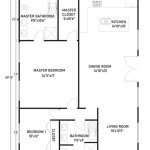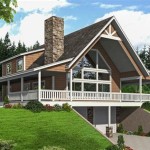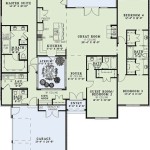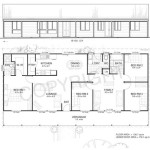Exploring New Orleans Style House Plans: A Guide to Timeless Elegance
New Orleans style house plans evoke a sense of history, charm, and architectural sophistication, drawing inspiration from the city's rich cultural heritage and unique environmental considerations. These plans often feature a blend of French, Spanish, and Caribbean influences, resulting in homes that are both aesthetically pleasing and well-suited to warm, humid climates. Understanding the key elements and variations within this architectural style is crucial for anyone considering building or renovating a home with a New Orleans flair.
The essence of New Orleans architecture lies in its ability to marry functionality with beauty. The design principles prioritize ventilation, natural light, and outdoor living spaces, acknowledging the importance of adapting to the regional climate while maintaining an elegant and refined aesthetic. This article delves into the defining characteristics of New Orleans style house plans, exploring the historical context, typical features, and variations that contribute to their enduring appeal.
Key Architectural Features of New Orleans Style Homes
Several defining features consistently appear in New Orleans style house plans, contributing to their distinctive character. These elements are not merely aesthetic choices; they are often rooted in practical considerations developed over centuries to address the specific needs of the region.
One of the most prominent features is the presence of balconies and galleries. These elevated outdoor spaces, often adorned with intricate ironwork railings, provide shaded areas for relaxation and socialization. Balconies and galleries also serve a functional purpose, offering ventilation and protection from the elements. They extend the living space beyond the confines of the interior walls, encouraging outdoor living—a hallmark of New Orleans culture.
Another common characteristic is the use of stucco or brick exterior finishes. Stucco, in particular, is well-suited to humid climates, offering durability and resistance to moisture. Brick, often used for foundations and accent walls, adds a sense of solidity and historical authenticity. The color palette typically favors light, neutral tones, reflecting sunlight and keeping interiors cooler. However, brighter colors, especially on doors and shutters, are also frequently used to add a touch of vibrancy and personality.
Windows and doors play a critical role in defining the architectural style. Tall, narrow windows maximize natural light and ventilation, while French doors often lead onto balconies or courtyards, blurring the lines between indoor and outdoor spaces. Shutters, both functional and decorative, provide protection from the sun and storms, adding visual appeal to the facade. The arrangement of windows and doors often reflects a symmetrical design, contributing to the overall sense of balance and harmony.
Rooflines in New Orleans style homes are typically steep-pitched, facilitating rainwater runoff. The use of materials like slate or metal roofing adds to the aesthetic appeal and provides long-lasting protection. Dormers, small windows projecting from the roof, are also common, providing additional light and ventilation to upper floors. The overall roof design often incorporates overhangs to provide shade and protect walls from the elements.
Variations and Influences in New Orleans Style House Plans
While certain features are consistently associated with New Orleans style homes, there is a considerable degree of variation depending on the specific historical period, geographical location within the region, and the preferences of the architect or homeowner. Understanding these variations allows for a more nuanced appreciation of the style's diversity.
The French Quarter, the oldest section of New Orleans, showcases a predominantly French-influenced architectural style characterized by ornate ironwork, courtyards, and balconies. Homes in this area often feature intricate details and a formal layout, reflecting the influence of European design principles. The use of vibrant colors and decorative elements is more pronounced in this area compared to other parts of the city.
The Garden District, known for its grand mansions and lush landscaping, exhibits a blend of architectural styles, including Greek Revival, Italianate, and American Victorian. However, many homes in this area also incorporate elements of New Orleans style, such as balconies, galleries, and courtyards. The scale of the homes in the Garden District is generally larger than those in the French Quarter, reflecting the prosperity of the residents who built them.
Shotgun houses, a common architectural type in New Orleans, are characterized by their narrow width and long, rectangular shape. These homes typically feature a series of rooms arranged linearly, with no hallways. Shotgun houses are a more modest and affordable housing option, but they still retain many of the key features of New Orleans style, such as balconies, shutters, and stucco exteriors. The simplicity of the design allows for efficient use of space and easy ventilation.
Creole cottages, another prevalent architectural type, are characterized by their symmetrical facade, hipped roof, and wide front porch. These cottages often feature French doors leading onto the porch, creating a seamless connection between indoor and outdoor spaces. Creole cottages are typically smaller than mansions, but they exude a sense of charm and elegance that is characteristic of New Orleans style.
The influence of Spanish architecture is evident in the use of courtyards and patios, which provide private outdoor spaces for relaxation and entertainment. Spanish colonial architecture also emphasizes the use of natural materials, such as wood and stone, and the incorporation of decorative elements like tiles and wrought iron. The blending of Spanish and French influences is a defining characteristic of New Orleans architecture, creating a unique and distinctive style.
Considerations for Implementing New Orleans Style in Modern House Plans
While New Orleans style house plans are rooted in history, they can be adapted to suit modern lifestyles and building practices. Careful consideration should be given to incorporating the key architectural features while addressing contemporary needs for energy efficiency, space utilization, and accessibility.
When planning a new construction or renovation, it is essential to prioritize energy efficiency. Modern insulation techniques, energy-efficient windows, and sustainable building materials can be incorporated without compromising the architectural integrity of the design. The use of solar panels and rainwater harvesting systems can further enhance the sustainability of the home. Maintaining proper ventilation is crucial in humid climates, and modern HVAC systems can be integrated discreetly to ensure effective air circulation.
The layout of the interior spaces should be carefully considered to maximize functionality and comfort. Open floor plans can be incorporated while still maintaining a sense of privacy and separation between different areas of the home. The use of natural light should be prioritized, with large windows and skylights strategically placed to illuminate the interior spaces. The incorporation of modern amenities, such as gourmet kitchens and luxurious bathrooms, can enhance the livability of the home without detracting from its historical charm.
Accessibility is another important consideration, particularly for homeowners who are aging in place or have mobility limitations. Ramps, elevators, and wider doorways can be incorporated seamlessly into the design to ensure that the home is accessible to everyone. The use of universal design principles can enhance the usability of the home for people of all ages and abilities. Careful planning and attention to detail are essential to create a home that is both beautiful and functional for all occupants.
The selection of materials and finishes is crucial to achieving an authentic New Orleans style aesthetic. Stucco or brick exteriors, wood floors, and wrought iron details are all essential elements. The color palette should be carefully chosen to reflect the historical character of the style, with light, neutral tones predominating. The use of decorative elements, such as chandeliers, sconces, and period-appropriate furniture, can further enhance the authenticity of the design. Consulting with an architect or interior designer who specializes in New Orleans style can be invaluable in ensuring that the design is both historically accurate and aesthetically pleasing.
Landscaping plays a vital role in complementing the architectural style of a New Orleans home. Lush gardens, courtyards, and patios are all essential elements. The use of native plants and flowers can enhance the beauty and sustainability of the landscape. Outdoor lighting should be carefully planned to create a welcoming and inviting atmosphere. The incorporation of water features, such as fountains and ponds, can add a sense of tranquility and serenity to the outdoor spaces.

New Orleans House Plan French Country Mediterranean Old World European Homes Traditional

New Orleans Houses Architecture Homes Creole Cottage

Image Result For New Orleans Style Stilt Homes Floor Plans Beach House

Pin On Home Ideas

Traditional Luxury Style House Plan 6900 Baton Rouge

Louisiana House Plans New Orleans Style The Designers

About Us Creole Design

New Orleans House Plan 30044rt Architectural Designs Plans

New Orleans Style Double Shot Gun House Design Ideas S 476 Sqm Homestyler

Pin On Great Home Remodel Items








